Gold Alloy This variety differs from pure gold in terms of its basic properties. This variety differs from pure gold in its basic properties. In most cases, you can tell whether the gold is fake or not by its appearance. The mixture of ligatures and precious metal was widely used in the past and has not lost its popularity today. Modern gold alloys are represented by a large number of types. You can find out how they differ by examining the tables containing the percentages ligatures.
Pure gold and its characteristics
It is found rarely in its pure form. It is mostly native gold. There are natural formations that are characterized by their large size. Each one has its own name, as it is rare. But in this form, the metal is not used in jewelry, space industry (when processing satellites), orthopedic dentistry and industry. The reason is its high softness and, on the contrary, its strength is low.
The precious metal is more often used to form a gold and currency reserve.
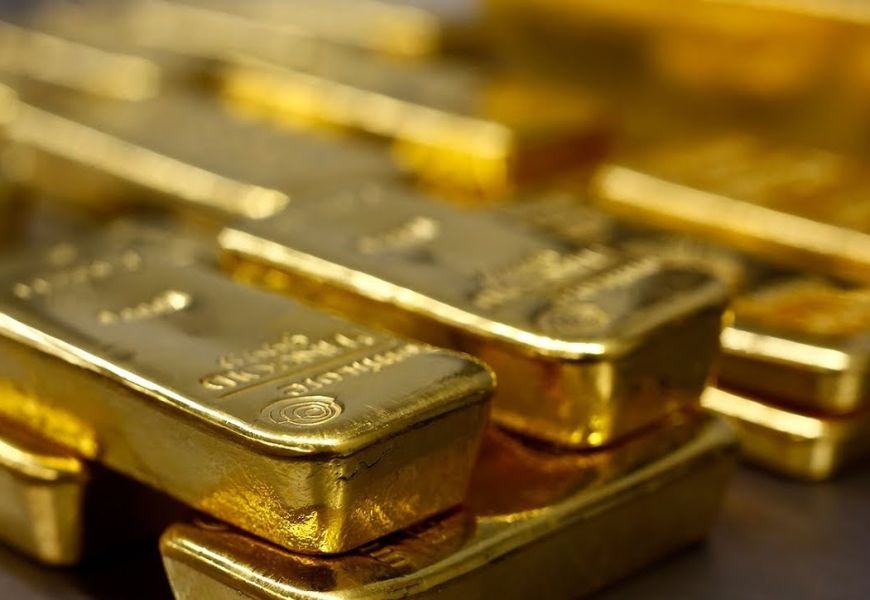
Pure gold is listed in the Mendeleev table under atomic number 79. It is distinguished by its characteristics:
- atomic mass is 196.966569 g/mol;
- metal density - not more than 19.32 g/cm3;
- melting point - 1,064.18 °C;
- the precious metal boils at 2856°C;
- thermal conductivity - 318 W/m*K.
Au is hard, and becomes liquid when combined with mercury (forms amalgam).
Gold grades in different alloys
The assay is called a type of branding that determines the weight content of Au in the composition of the precious metal. Today in Russia the metric system is used for this purpose. On its basis, according to GOST 30649-99, alloys with special properties and different colors are obtained. The most common ones are:
- 999 or 99.9% - pure gold, the content of the precious metal is the highest (but a small percentage of impurities is still acceptable), even less additives may be only in a nugget;
- 750 or 75% is the more common variant, the amount of Au is substantial, which increases the value of jewelry, other products, but because of this decreases the strength;
- 585 or 58.5% is the most popular type of yellow precious metal, it features the best ratio of ligatures and gold, which allows to obtain excellent characteristics (high wear resistance, strength, moderate ductility);
- 500 or 50% - the gold content is at the lower limit, which allows you to attribute the alloy to the precious metals, the strength is higher than that of products 585 grade, but the value is lower, which affects the price (products are more affordable);
- 375 or 37.5% - a rarer alloy, but still used, the Au content is minimal, the value is low, but this kind of jewelry is resistant to mechanical damage, although at a price closer to the premium costume jewelry.
Note: The main varieties of ligature are copper, silver, platinum group substances, brass and other precious, non-precious metals.
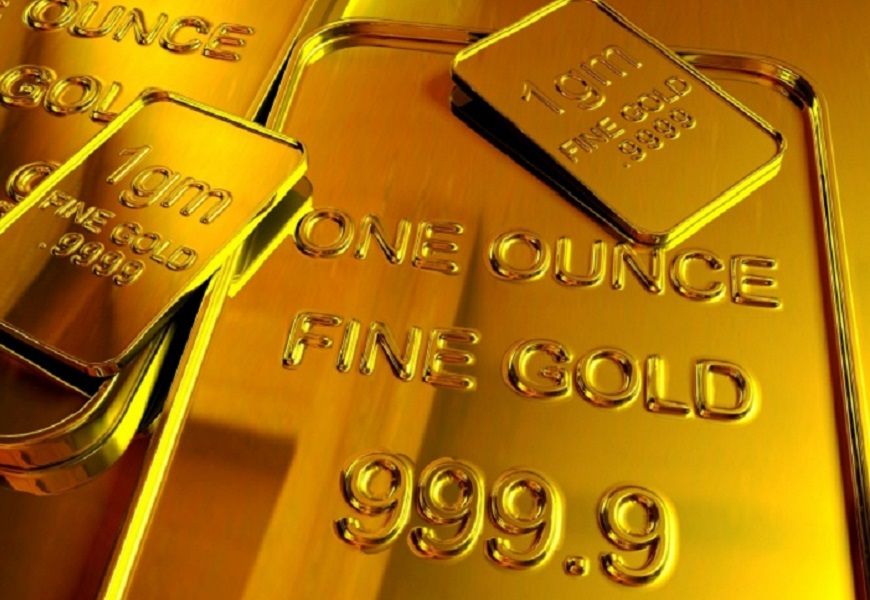
Ligature metals in alloys with gold and their properties
In ancient times purer gold was often used, but the size of coins quickly changed with intensive use (they wore off), so another technique was used to produce the precious metal. They added alloys, chose the proportions that would allow to create the material with the most suitable characteristics: high value and durability. The properties of the additives were taken into account. The list of the most common ones:
- silver for softness: the main advantage of introducing such a ligature is the ability to increase the malleability, ductility, in addition, the precious metal takes on a lighter shade, with the right ratio becomes white, but the more silver, the lower the value of the product;
- Copper for a red hue: used to alloy with gold, allows you to change the strength index Au (products better able to withstand mechanical stress), as well as its color - the precious metal becomes a red hue, unlike silver, the addition of a small percentage of copper (14-15%) will make it red;
- Nickel for hardness: is characterized by increased hardness, resistance to corrosion, which allows the use of precious metal in dentistry, jewelry industry, the disadvantage is the risk of allergies when in contact with the skin;
- Palladium for refractoriness: in order to obtain a material of higher hardness, the chemical formula is changed by adding palladium. At the same time, the price of the product increases because this ligature is also a precious metal and also contributes to the change in color to a lighter (white);
- Platinum for whiteness: used to change the color of the alloy, it is enough to increase the platinum content to 8.4% to get a white precious metal, in addition, the addition of this ligature contributes to the elasticity of gold, the melting point, which makes it somewhat difficult to work with the products;
- Ruthenium for strength: increases the melting point so that the gold has to be heated harder to change its shape, making it stronger, but ruthenium has no effect on its shade;
- Iridium for wear resistance: not used to produce an alloy of a different color, but used to change the properties of the precious metal, as a result, gold becomes even more resilient than when combined with iridium, the products are much worse to process;
- Osmium for elasticity: the ligature has many properties in common with ruthenium, iridium, the introduction of such metal in the composition changes the melting temperature - it increases, it becomes more difficult to work with the material, but the elasticity increases, its resistance to deformation, but the point blow will not survive;
- cadmium for fusibility: unlike osmium, iridium and other ligatures, cadmium, on the contrary, reduces the melting point of the gold mixture, which facilitates working with it, the precious metal becomes more plastic, but also brittle, as it does not always withstand the mechanical loads imposed when using the product, in addition, the gold alloy slightly changes color - a greenish hue appears, but there are other alloys to obtain such a tone, cadmium more often perform other tasks;
- Zinc for a green shade: the properties resemble cadmium, also contributes to the appearance of green color, but with the choice of a suitable base (ligature) can eliminate this drawback, in addition, zinc increases the hardness of the material, but it is also easier to damage, because the degree of fragility increases, with point hits the product can be destroyed, in addition, ligature helps to reduce the melting temperature;
- Aluminum for plasticity and unusual shades of gold alloys: one of the types of ligatures used in obtaining various precious metals, aluminum is introduced into the alloy purple color.
Interesting: A superhard metal - based on Au and Ti (titanium) - has recently been invented.
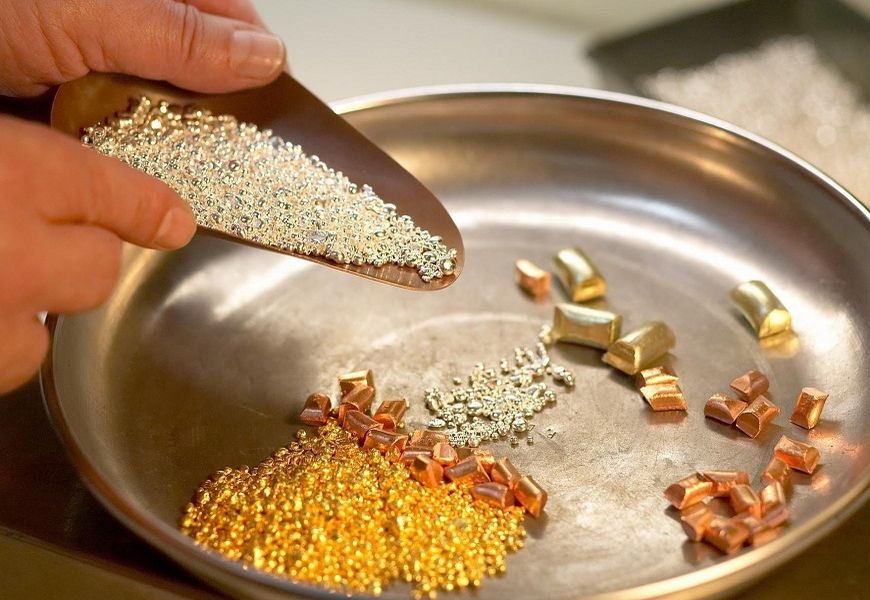
The principle of alloying gold with metals
A material that is more suitable for processing is one that is ductile, has a low melting point, and is strong. The choice of ligatures, their combination with each other, allows you to find the best option, taking into account the given characteristics. When one of the additives is introduced, the composition of the material changes. To adjust the result, the next additive is added. For this reason, a metal can have 1-2 or more additives.
Note: The homonizing procedure is carried out to increase the degree of homogeneity of the precious metal, the desired result is achieved by reheating to a temperature of +700 ° C, further holding the alloy improves the structure.
Alloys of different gold colors
The choice of ligatures is made on the basis of the properties they exhibit when combined with Au. It is not guided by the characteristics of the metal itself, which acts as an additive. The result of combining precious and non-precious materials:
- yellow - The classic combination of gold and in addition copper and silver: the classic version, to obtain the yellow metal, gold must exceed the other additives in quantity, a special, richer color is obtained through a combination of silver and copper, and it is the latter of the ligatures enhances the depth of color, and silver does not allow to increase the intensity of red tone;
- red - popular duo Au and Cu: a metal of this color began to be used in Russia in the XVIII century, reduced copper content and additional additives (silver) allows you to get a pink gold, it is based on a red alloy, but other properties, as the ratio of components significantly different;
- White - The addition of various alloys for a refined white color: the metal has another name - "white gold", but the main component is still Au, changing its classic yellow color platinum group metals used as alloys, as well as manganese, nickel, as a result of which products may have other properties than those of platinum jewelry - increased fusibility, which increases the variety of forms and design of jewelry;
- black - alloy as a result of oxidation with cobalt: ring, bracelet acquires this color, if the manufacture has been oxidized with cobalt, an alternative option - dressing with the addition of carbon, simulates a similar color also patinated, rhodium-plated;
- green - Alloy includes gold with a silver ligature: such items have a name - "electrum", the metal containing a certain proportion of Ag, characterized by a slight green hue, more pronounced such color appears if the gold is alloyed with cadmium, but such jewelry is not recommended for long wear, can cause damage to health;
- blue and blue is a spectacular alloy with indium: it is not strong enough, so platinum group metals are often introduced, indium gives the blue color, and blue gold is an iridium-based alloy;
- Purple - a mysterious alloy of gold with aluminum and palladium: a rare combination, so occurs infrequently, it is mainly used to manufacture inserts, the drawback is the fragility.
Interesting: in ancient Greece, the alloy of gold as well as silver had a certain name - electron.
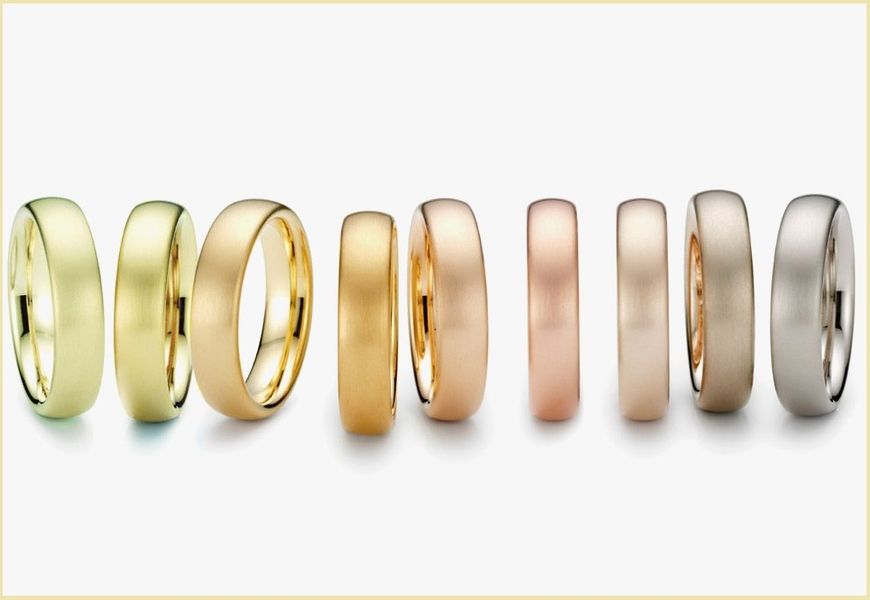
Gold imitations
The metal may not contain Au, but it must have similar appearance in order to be considered similar to the original. Such products have no value, but they have a wide range of applications, for example, the production of costume jewelry is the main direction. List of metals that imitate gold alloy:
- Bronze: copper with the addition of aluminum, the first of the components gives a red hue, the second - lightens the tone;
- vermei: silver with gilding, the appearance of Au is retained, but the items are lighter;
- gameltonmetal: a method of coating products that was previously often used, the metal contained copper, zinc.
Medical gold alloy
It is a steel, different in composition, as the content of the main additives is not regulated. The medical alloy is very similar to gold, but has different properties: harder, better endures mechanical stresses, but costs much less. If you managed to buy this type of product at a high price, you should remember that this is a deception, because in this case, the jewelry is passed off as precious.
Deciphering the marking of alloys that contain gold
Materials are labeled for ease of handling. For precious metals, in addition to the letter designation, an additional numerical designation is generally accepted - fractions of a thousandth, and for non-precious alloys - hundredths (%). Common variants that are found in GOST:
- Gold - Zl;
- silver - cf;
- Platinum - Pl;
- copper - M;
- zinc - C;
- nickel - N;
- cadmium - Cd;
- palladium - Pd.
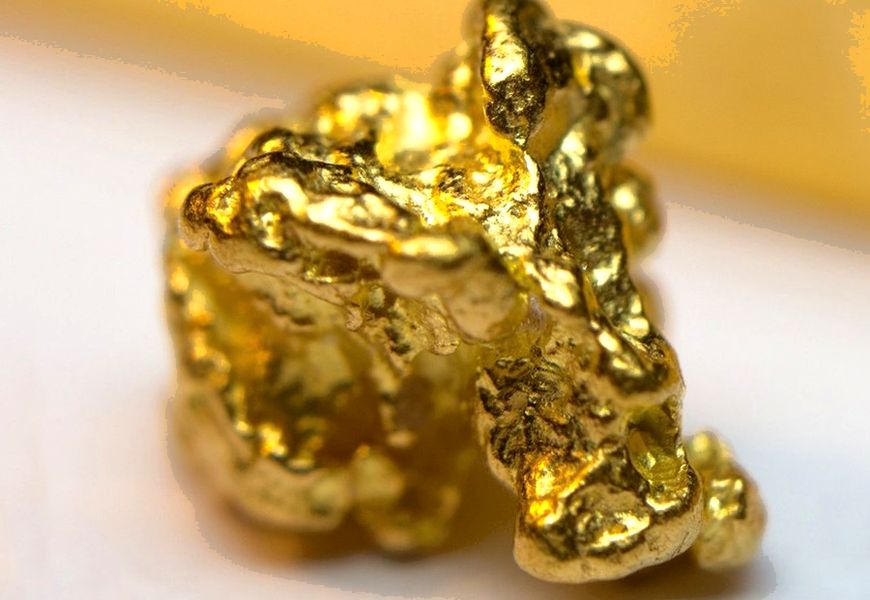
World systems for measuring the purity of gold precious metals
At different times, a variety of methods have been used to determine the Au content of the metal alloy. At the same time, the amount of ligatures that were added at the manufacturing stage varies: from 10-12% to 80%. But the best variant in appearance and properties is the one containing 30-40% additives. There are only 4 known ways to measure the purity of the precious metal:
- widespread metric system: the fraction of the precious metal is determined in thousandths (range from 0 to 1000);
- Carat system, applicable in the U.S. and Europe: the basis for the value - 24 carats, this precious metal without impurities, respectively, the gold content of the various alloys is defined as the number of parts 1/24 of pure substance (corresponding to 1 carat);
- the tsarist Russia's system of gold pieces: the basis was a measure - 96 proof of pure precious metal, corresponding to the number of gold pieces in 1 Russian pound;
- The lot system of Old Europe: 16 lots were considered pure metal; the lower the number, the lower the value of the items.
How alloys can change the appearance of a product
According to GOST, the difference between the metals of the same group can be small or significant. However, the gold content in the alloy is always the same, despite changes in the proportions included in the ligatures. The hue changes when the amount of basic additives varies: silver, copper, which determines the depth of color.
Table 1: Alloys with Au in composition, 375 samples
Metal based, Ag, Au, Cu are represented by options:
| Au, % | Ag, % | Cu, % |
|---|---|---|
| 37,2-37,8 | 1,5-2,5 | 59,5-61,5 |
| 9,5-10,5 | 51,5-53,5 | |
| 15,5-16,5 | 45,6-47,4 |
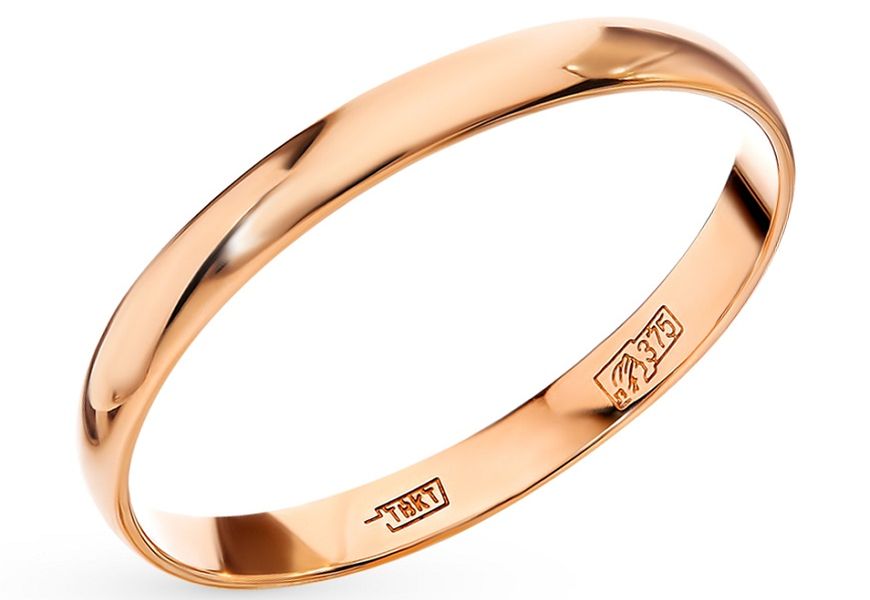
Table 2: Alloys that contain Au 500 of the sample
| Gold, % | Silver, % | Copper, % |
|---|---|---|
| 49,7-50,3 | 9,5-10,5 | 39,2-40,8 |
| 19,5-20,5 | 29,2-30,8 |
Table 3: Alloys based on Au 583
| Gold, % | Silver, % | Copper, % |
|---|---|---|
| 58,0-58,6 | 7,5-8,5 | 32,9-34,5 |
| 19,5-20,5 | 21,1-22,3 | |
| 29,5-30,5 | 11,2-12,2 |
Table 4: Alloys based on Au 585
| Au, % | Ag, % | Cu, % |
|---|---|---|
| 58,5-59,0 | 7,5-8,5 | 32,5-34,0 |
| 19,5-20,5 | 20,5-22,0 | |
| 29,5-30,5 | 10,5-12,0 |

Table 5: Alloys 750
| Au, % | Ag, % | Cu, % |
|---|---|---|
| Au, % | Ag, % | Cu, % |
| 74,7-75,3 | 12,0-13,0 | 12,0-13,0 |
| 14,5-15,5 | 9,5-10,5 |
Table 6: Alloys 958
| Au, % | Ag, % | Cu, % |
|---|---|---|
| Ag, % | Ag, % | Cu, % |
| 95,5-96,1 | 1,5-2,5 | 1,7-2,5 |
Video: precious metals
Jeweler's comment

Testimonial
I have different jewelry: light yellow, reddish, deep yellow. The price was about the same, so I thought that was how the jeweler handled it, and maybe it wasn't gold at all. Only recently I found out when I had it evaluated that all of the jewelry is real, but the composition is slightly different. The main thing for me is that there is enough precious metal.

